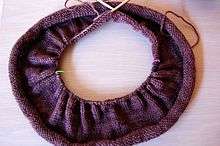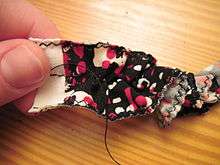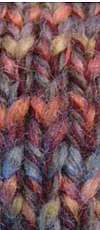Gather (knitting)
In knitting, a gather draws stitches closer together within a row of knitting. Common methods include:
- In binding, a yarn loop is passed over 2 or more stitches in the same row (usually adjacent to the binding loop); also known as a pullover stitch.
- In clustering, the yarn is wound laterally around a set of stitches in the same row, possibly several times; also known as a wrap stitch.
- Smocking is a sewing or embroidery technique in which the tiny pleats are drawn together with thread or yarn. Before the development of elastic, smocking was used to provide a stretchable, flexible panel of fabric.

Gathers knit into a pullover sweater using stitch decreases.
Related techniques

Ruching created by sewing stitches down the centre of a fabric strip, then pulling one end of the thread to gather the fabric.
In the sewing technique ruching (pronounced /ˈruːʃɪŋ/, ROO-shing also spelled rouching), a large number of increases are introduced in one row, which are then removed by decreases a few rows later. This produces many small vertical ripples or "ruches" in the fabric, effectively little pleats. The technique of shirring produces a similar effect by gathering the fabric in two parallel rows (not necessarily horizontal), usually by smocking.
gollark: That would be a spoiler. No.
gollark: What, all of them?
gollark: Also, the infipage has been upgraded: https://osmarks.tk/infipage/p
gollark: The biggest number is 8.00004.
gollark: ???
References
- Hiatt, June Hemmons (1988). The Principles of Knitting. Simon and Schuster. pp. 55–56, 82–83. ISBN 0-671-55233-3. OCLC 17325110.
This article is issued from Wikipedia. The text is licensed under Creative Commons - Attribution - Sharealike. Additional terms may apply for the media files.
